
Old Northside is a residential neighborhood near downtown in Indianapolis, Indiana. It is bordered by 16th Street on the north, Pennsylvania Street on the west, Interstate I-65 on the south, and Bellefontaine Street on the east. The Monon Trail runs along the eastern edge of The Frank and Judy O'Bannon Old Northside Soccer Park.

Knights of Pythias Lodge is a historic Knights of Pythias building located at South Bend, St. Joseph County, Indiana. It was built in 1922, and is a seven-story, Commercial style brick building with terra cotta. The building features applied Classical Revival style design elements.

Knights of Columbus-Indiana Club is a historic Knights of Columbus building located at South Bend, St. Joseph County, Indiana. It was built in 1924, and is a three-story, Renaissance Revival style brick and terra cotta building. The building features round arched windows with radiating voussoirs of brick and terra cotta.

Sunken Gardens is a historic public park and garden complex located at Huntington, Huntington County, Indiana. It was designed by the Chicago Landscape Co. in 1923, and complete in 1929. The gardens include outcropped limestone walls on all sides, a horseshoe shaped pool, limestone foot bridges, two levels, and an automobile-related fieldstone bridge.
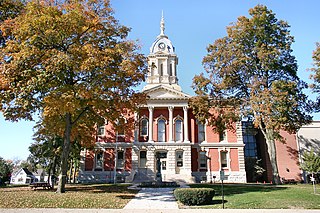
Marshall County Courthouse is a historic courthouse located at Plymouth, Marshall County, Indiana. It was built between 1870 and 1872, and is a two-story, brick and limestone building in a combination of Italianate and Renaissance Revival styles. It is rectangular in form and has a hipped roof with central bell tower.

Honey Creek School is a historic one-room school building located in Benton Township, Monroe County, Indiana. It was built in 1921, and is a one-story, Bungalow / American Craftsman influenced balloon frame building on a fieldstone foundation. The main section has a hipped roof and a projecting gable roofed entry is topped by a belfry with a pyramidal roof. The school closed in 1945. The building was restored in 1975.
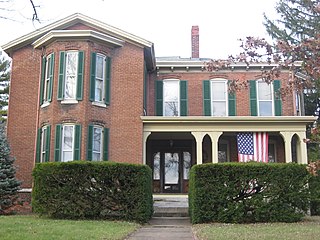
Martinsville Northside Historic District is a national historic district located at Martinsville, Morgan County, Indiana. The district encompasses 96 contributing buildings and 11 contributing structures in a predominantly residential section of Martinsville. It developed between about 1850 and 1935, and includes notable examples of Queen Anne and Bungalow/American Craftsman style architecture. Notable buildings include the Brown-Haworth House, William R. Harrison House / Bates House, St. Martin of Tours Roman Catholic Church (1889), Elliott House (1865), Kriner House, and Schofield-Maxwell House. The formerly listed Hite-Finney House was located in the district.

John G. Kerr Company is a historic commercial building located at South Bend, St. Joseph County, Indiana. It was built in 1891, and is a three-story, Italianate style brick building. It round arched windows and a cast iron storefront. It is located next to the Second St. Joseph Hotel.

Old Courthouse, also known as the Second St. Joseph County Courthouse, is a historic courthouse located at South Bend, St. Joseph County, Indiana. It was designed by architect John M. Van Osdel (1811-1891) and built in 1853. It is a two-story, Greek Revival style stone building. The building measures 61 feet wide and 93 feet deep. It features a projecting front portico supported by Doric order columns and a front gable roof topped by a cupola. It was moved to its present site in 1896. Following construction of the Third St. Joseph County Courthouse, the building housed the local G.A.R. chapter and historical museum. The building now houses office of the Traffic and Misdemeanor Court and Small Claims Court.

Garth Stroup House, also known as the Merrifield-Cass House, is a historic home located at Mishawaka, St. Joseph County, Indiana. The original one-story dwelling was built in 1837, and enlarged to two-stories and one-story wing added in 1867. The frame dwelling exhibits Greek Revival, Federal, and Carpenter Gothic style design elements. It sits on a fieldstone and brick foundation. It features porches with gingerbread trim. The house is thought to be the oldest dwelling in continuing use in Mishawaka.

Martin Wenger House is a historic home located at South Bend, St. Joseph County, Indiana. It was built in 1851, and is a two-story, Italianate style frame dwelling. It sits on a fieldstone foundation and has a low-pitched hipped roof. It features a full-width front porch, paired scroll-sawn brackets, and round arched window openings.

Wertz–Bestle Farm is a historic home and farm located in German Township, St. Joseph County, Indiana. The house was built about 1872, and is a two-story, "T"-plan, Italianate style brick dwelling with a 1 1/2-story kitchen wing. It sits on a fieldstone foundation and has bracketed eaves and segmental arched windows. Also on the property is the contributing 3 1/2-story, two-level, Schweitzer barn.
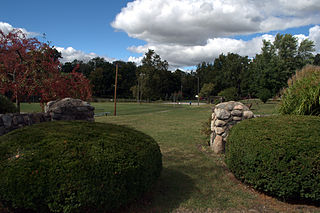
North Liberty Park, also known as North Liberty Community Park, is a historic public park and national historic district located at North Liberty, St. Joseph County, Indiana. The district encompasses two contributing buildings, one contributing site, three contributing structures, and two contributing objects in a public park. It was developed by the Works Progress Administration in 1935 and 1937. They constructed the ornamental fieldstone entrance structures, a footbridge, bandshell, tool shed, bath house, and other fieldstone features.
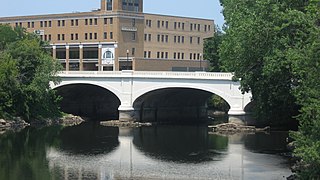
La Salle Street Bridge is a historic Spandrel Arch bridge located at South Bend, St. Joseph County, Indiana. It was built in 1907, and is a three-span, reinforced concrete bridge that crosses the St. Joseph River. It measures 279 feet long and 51 feet wide.

Walker Field Shelterhouse is a historic park shelter located at South Bend, St. Joseph County, Indiana. It was constructed in 1938 by the Works Progress Administration. It is a one-story, "T"-shaped fieldstone building. It consists of a gable roofed section with attached hipped roof arcades enclosing space for a wading pool. The central section features three wide segmental arched openings.
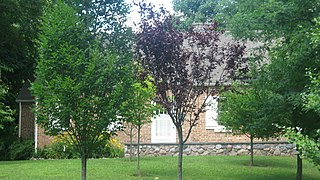
Mishawaka Reservoir Caretaker's Residence is a historic home located in Penn Township, St. Joseph County, Indiana. The house was built in 1938 by the Works Progress Administration as a home for the caretaker of the Mishawaka Reservoir. It is a 1 1/2-story, rectangular, solid brick dwelling. It has a three-sided bay window, gable roof, and fieldstone chimney. The building was moved to its present location in 1995 to save it from demolition.

Hershey House, also known as the Patrick Home, is a historic home located in Perry Township, Tippecanoe County, Indiana. It was built in 1856, and is a two-story, Greek Revival style brick dwelling, with a 1 1/2-story rear wing. It is three bays wide and has a gable front roof. Also on the property is a contributing fieldstone milk house. It was the home of William Hershey, son of the builder Joseph M. Hershey, who served with the 16th Independent Battery Indiana Light Artillery in the American Civil War and witnessed the assassination of Abraham Lincoln.

Bals–Wocher House is a historic home located in Indianapolis, Indiana. It was built in 1869-1870, and is a three-story, Italianate style brick dwelling with heavy limestone trim. It has a low hipped roof with deck and paired brackets on the overhanging eaves. It features stone quoins and an off-center arcaded loggia.

Pearson Terrace is a historic rowhouse block located at Indianapolis, Indiana. It was built in 1901-1902, and is a two-story, seven unit, vernacular Queen Anne style grey brick row with limestone trim. It sits on a raised basement and has a complex gable roof. It features a projecting two bay center unit and projecting window bay.
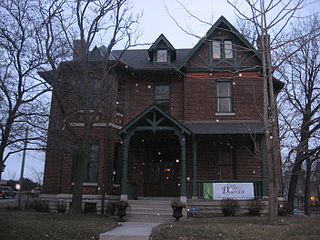
St. Joseph Neighborhood Historic District is a national historic district located at Indianapolis, Indiana. The district encompasses 57 contributing buildings in a predominantly residential section of Indianapolis. It was developed between about 1855 and 1930, and include representative examples of Italianate and Queen Anne style architecture. Located in the district are the separately listed Bals-Wocher House, William Buschmann Block, Delaware Court, Pearson Terrace, and The Spink. Other notable buildings include the Christian Place complex, Fishback-Vonnegut-New House, Henry Hilker House, Apollo-Aurora Rowhouses, Israel Traub Store, and Lorenzo Moody House.



























